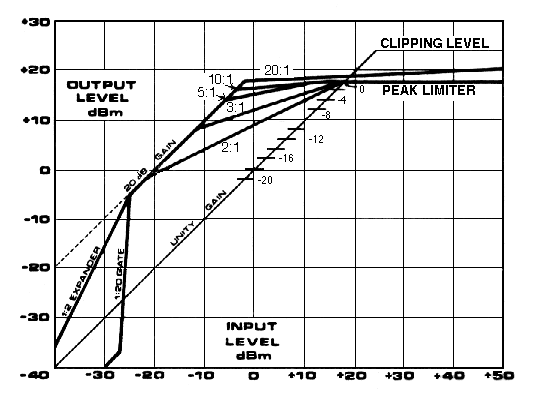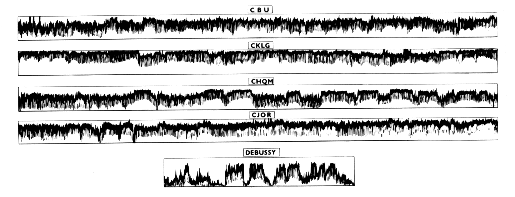|
|
The control of sound levels to ensure suitable placement between the lowest and highest distortion-free levels of an electroacoustical system.
See: DYNAMIC RANGE. Compare: LIMITER, PEAK CLIPPING, RECTIFICATION.
Compression may be thought of as a form of non-LINEAR amplification where peak levels above a certain threshold are amplified according to input-to-output ratios such as 2:1, 3:1, 5:1, 10:1 or 20:1 which reduce the peak levels accordingly. Compressors may be combined with dynamic range expanders which suppress low level signals below a threshold according to a 1:2 or 1:20 ratio, the latter being called a gate because low level signals such as BACKGROUND NOISE are effectively eliminated.

The relation of input level to output level in a compressor, limiter and expander showing patterns of amplification that affect dynamic range by departing from unity gain (1:1 ratio).
In popular music recording and commercial radio broadcasting, automatic compression brings peak intensities consistently to full MODULATION of the CARRIER. This is done, in part, to compensate for the inferior quality of most low cost radios and reproduction systems, and their inability to reproduce a wide range of frequencies and/or dynamics. A compressed signal will sound better than an uncompressed one on these receivers. Full modulation of the signal also effectively maximizes the physical area over which the signal may be received, thus ensuring the largest possible market audiences which may be offered to advertisers. Radio commercials, however, generally have a larger dynamic range, presumably to attract the listener's attention. See also: DAMAGE-RISK CRITERIA.
The following chart shows the intensity levels of four AM radio stations in Vancouver over an hour period, where the signal has been compressed to different extents such that the output rides near a maximum level. For comparison, the contours of a work by Debussy are shown.

Radio intensity contours for a one-hour period compared with a segment of a CBC broadcast of Debussy's Nocturnes (from The Vancouver Soundscape, No. 2, Music of the Environment series, World Soundscape Project, 1974).
The term 'compression' or condensation is also used to indicate that part of a SOUND WAVE where the pressure is greater than the normal atmospheric pressure. It is the opposite of RAREFACTION. The displacement of air particles within a CYCLE involves alternations of compressions and rarefactions to produce sound.

See diagram under SOUND PRESSURE. Compare: INTERFERENCE.
home